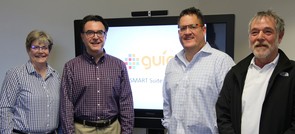University of Arizona faculty, in conjunction with Tech Launch Arizona and a local entrepreneur, have invented and licensed a sensor platform currently designed for mines. With a focus on people’s health and safety, this application of sensor technology is the first of its kind.
The System for Managing Advanced Response Technology Suite 5.0, or SMART, is designed to prevent accidents through monitoring worker health and environmental conditions.
The team of inventors includes Mary Poulton, director of the UA’s Institute for Mineral Resources, Moe Momayez, associate professor of Mining Engineering and Sergio Cardona, an Oro Valley technology entrepreneur.
RELATED: Mexican product distributor buys rights to sunscreen invented at UA
Both Momayez and Poulton work in mining health and safety at the UA. Their idea was to leverage the existing technology to help mines become safer, concentrating on workers.
Mines are still considered dangerous environments. Though the rates of injuries and fatalities have reached an all-time low, many mine shifts are eight long hours of demanding work.
“Sometimes you’re distracted, sometimes you get tired,” Momayez said. “When the distraction and the fatigue settles in, people just act and react — they stop thinking. So we want to prevent those kinds of problems.”
The SMART Suite 5.0 will help prevent accidents through a network of mobile and static nodes. A node is a piece of equipment that houses, in this case, up to 256 sensors. The mobile nodes will be either a health bracelet or a chest band on each worker, reading a whole range of physiological signals and streaming the data to a server.
Through continually developing algorithms, this server will aim to predict when a situation becomes unsafe for a worker and alert the manager.
The static nodes will monitor ground movements, temperature, air quality and other factors that could contribute to an accident. One key feature of this system is that, unlike similar technologies, it will not rely on an already existing internet connection — each node will have the ability to become a router.
Developing the idea to a point of marketability did not come without hurdles. The TLA program “really coached us every step of the way,” Poulton said. “I have a huge amount of respect for the organization.”
She and Momayez both describe positive experiences working with TLA, through which they accessed advisors and project funding.
TLA is a UA program that facilitates university discoveries and ideas so that they can be marketed to the public. The program describes its primary focus as “ensuring that technologies and innovations originating with UA researchers find meaningful application.”
RELATED: Tech Launch Arizona sets performance records in its third year
One of the greatest challenges with any new invention is identifying what the need is and how to fill it, according to Poulton. She advises any aspiring inventors to work with TLA to develop their projects.
For SMART Suite 5.0, the next step is a demo at the San Xavier mine. They are currently testing the nodes and preparing for the demo. “I’m very excited, can’t wait actually,” Momayez said. Currently the invention is being applied toward mines, though it could be used in many work environments such as agriculture, oil and gas, and construction.
Momayez hopes that through widespread adoption of this technology, many more lives will be saved.
Follow the Daily Wildcat on Twitter









